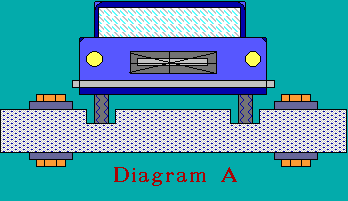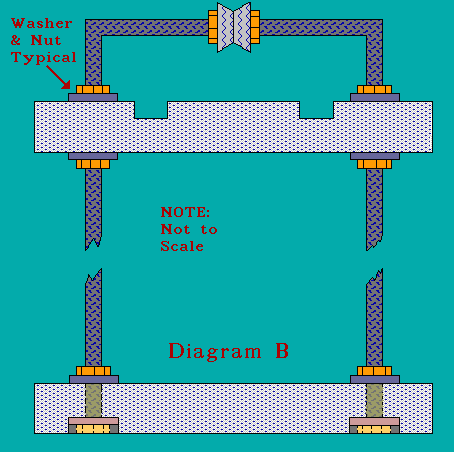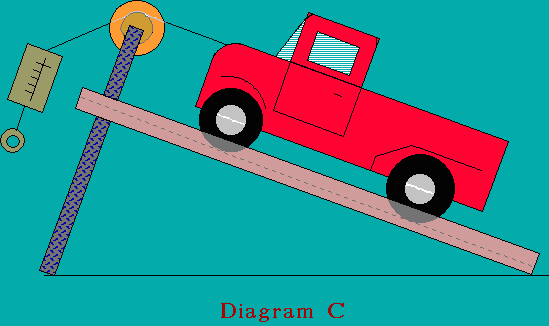ENERGY AND WEIGHT RELATIONSHIPS
- GOAL:
- To assist students in becoming wise energy consumers by understanding how increasing the weight of a vehicle will result in a decrease in fuel economy.
- OBJECTIVE:
- The student will be able to:
- 1. Determine the relationship between increased weight and added energy costs.
- 2. Realize that heavier vehicles require more energy to move and continue moving.
- 3. To demonstrate the energy savings by reducing the payload of a vehicle.
- LESSON/INFORMATION:
- Vehicles are lighter today than they were 15 or 20 years ago. This weight reduction has played a significant part in increasing the fuel economy (MPG) for transportation. The trucking and airline industries have always been keenly aware of their net weight since the net over road or net aircraft weight is restricted. This restriction forced those industries to build trucks and airplanes of very strong, light weight materials. By using higher tensile strength and lighter weight materials, more payload may be transported for the same given amount of energy. For example, if the load limit on a given road is 80,000 pounds and a given truck weighs 17,000 pounds, the net payload is 63,000 pounds. If that same truck weighed only 15,000 pounds, then that 2,000 pounds could increase the payload to 65,000 pounds. Usually trucking rates are calculated by the weight per mile. Suppose that a carrier charges $.02 per pound for each 100 miles. A typical over-the-road truck averages 200,000 miles a year. A trucking company with trucks that weigh 2,000 pounds less can potentially increase their yearly revenues by $80,000.
- $.02/100 miles x 2,000#/year = $40.00/100 miles-year
- $40.00/100 miles-year x 200,000 miles = $80,000/year
- Unnecessary weight increases a vehicle's energy cost and decreases fuel economy. For passenger cars and light trucks, there is a fuel penalty of approximately 0.09 MPG for each 100 pounds of weight. For example, having an unnecessary 50 pound tool box in the trunk of a car can decrease that vehicle's fuel economy by .045 MPG. Towing a boat or camper trailer places a heavier load on the vehicle thus decreasing the fuel economy. Towing also increases the wind resistance creating an even greater load resulting in an even greater loss of MPG. The faster a trailer is towed, the more significant is the drag or wind turbulence factor.
- Materials:
- 1. Small plastic dump truck (8-12" long).
- 2. 6" X 36" piece of 3/4" plywood; 8" X 2" piece of 3/4" plywood.
- 3. Grooved wheel 1" to 3" in diameter.
- 4. 3' piece of threaded rod that fits inside of the grooved wheel.
- 5. 10 washers and 10 nuts to fit the threaded rod.
- 6. One spring pull gauge (reads in ounces and fractions of an ounce.)
- 7. 4' length of light weight string.
- 8. 12 large flat washers.
- Activity:
- 1. Locate a small (8" to 12") plastic (Dump) truck that has moveable wheels.
- 2. Construct a wooden track for the truck to roll in so wheels have clearance but will keep the truck rolling in a straight line. See Diagram A.

- 3. Locate a grooved pulley (suggestion: hardware stores have universal wheels for under $3.00 or use an Erector set wheel). Install threaded rod into wheel and secure with washers and nuts.
- 4. Bend the threaded rod in a "U" shape to match dimension across the track and secure to the board with washers and nuts; attach the base board with washers and nuts.
- 5. Final assembly is shown in Diagram B and C.


- 6. Attach string to truck front. Tie a loop on other end of the string.
- 7. Place truck on track; make sure the track is steady and the string moves freely over the grooved wheel.
- 8. Run string in groove of wheel and attach spring gauge.
- 9. Proceed to pull the truck up the hill with the spring gauge.
- 10. In the appropriate block of the data sheet, record the number of ounces required to start the truck moving and keep it moving. Repeat this process five times.
- 11. Add 6 of the flat washers (half load) to the truck bed.
- 12. Repeat steps 9 and 10.
- 13. Add the remaining 6 washers (full load).
- 14. Repeat steps 9 through 10.
- 15. Drop each of the highest and lowest readings for each weight pulled. Average the three remaining.
-
Data Sheet
|
|
Truck Only
(ounces ) |
Half Load
(ounces) |
Full Load
(ounces) |
| First Try |
|
|
|
| Second Try |
|
|
|
| Third Try |
|
|
|
| Fourth Try |
|
|
|
| Fifth Try |
|
|
|
| Average |
|
|
|
- Conclusions:
- 1. Compare the force necessary to pull the truck empty, 1/2 full, and full.
- 2. How much more force was necessary to move the 1/2 load (in percent)? The full load?
- 3. What can be said about weight and energy usage?
- Information Check
- Place a "T" before the statements that are true and an "F" before the statements that are false. After each false statement, explain why it is false.
- _______1. The heavier a vehicle is the more fuel it will burn on any given trip.
- _______2. The extra trailer load is the only reason for a towing vehicle's reduced fuel economy.
- _______3. Vehicles produced today are lighter weight than vehicles produced ten or fifteen years ago.
- _______4. The aircraft and trucking industries have traditionally used very strong but light weight materials for constructing their vehicles.
- _______5. The speed at which a trailer is towed will have no effect on the towing vehicle's MPG.
- Teacher's Notes
- Students need to understand the relationship between MPG and vehicle weight. To move more weight--be it a heavier vehicle, increased load in the vehicle, or towing a trailer--more fuel must be burned. By performing this simple experiment with a small toy truck, students should be able to understand and grasp this important relationship. Once this relationship is understood, students will be more cautious about carrying unnecessary items in their vehicle. Additionally, students should realize that towing a trailer decreases MPG; however, towing a trailer at higher speeds decreases MPG even more. Lastly, when most people purchase a new vehicle the size / weight and MPG relationship is often overlooked. A considerable percentage of the increased MPG in our newest built vehicles is attributable to lower vehicle weight and lower coefficients of drag. Finally, it may give further credence to this weight and reduced MPG concept by introducing this lesson with an opening general discussion question. Ask the students if they notice any difference in MPG when they tow a boat or a camper. Another approach might be to ask the group if they know how many MPGs a motor home or large truck gets. Ask them to compare these MPGs to their personal car or light truck.
- Terms which may need to be explained are:
- Payload: The difference between the weight of an empty vehicle and a loaded vehicle.
- Tensile Strength: The net strength of a material when subjected to a pulling and/or twisting test. Strength can be independent of weight or thickness.
- If you have difficulty in obtaining a reading on the spring gauge, add some weight to the truck by bolting a piece of metal to the truck under body. If this is done, then cut some small pieces of metal of equal size and weight to use in lieu of the washers. To keep this experiment realistic, it is important that the weight ratio of empty truck and the truck payload range from 3:1 to 4:1.
- Answers for the Information Check.
- 2. False. The added wind resistance and drag also reduces the MPG of the towing vehicle.
- 5. False. After 35 to 45 MPH, the faster any vehicle travels, the lower the MPG; the lowering MPG with speed is even greater when a trailer is pulled. The effects of the coefficient drag becomes more pronounced with higher and higher speeds.
- Recommended Reading:
- Energy Conservation Information for Vehicle Owners, United States Department of Energy. DOE/CE-0297P. U.S. Government Printing Office. 1991.
Comments or questions to: TechAsmt@LA.GOV
Return to Transportation Menu





